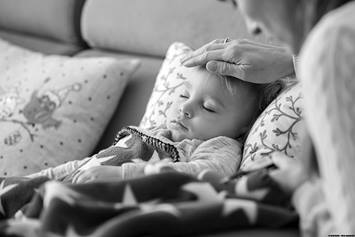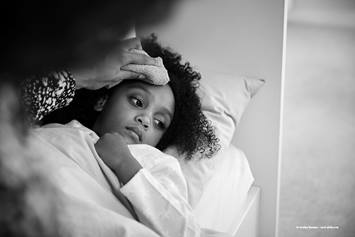Pneumonia
Pneumonia is a lung infection that can make you feel sick. It happens when germs get into your lungs. Symptoms include coughing, fever and difficulty breathing.
What Is Pneumonia?
Pneumonia is a lung infection. It’s usually caused by a virus or bacteria. These germs make the air sacs in the lungs fill with a fluid called mucus. This makes it harder to breathe and causes your child to cough.
Pneumonia occurs most often during the cold months when children spend a lot of time inside with other people. Children under the age of 2 are at the highest risk for pneumonia. Pneumonia can be treated.
‘Walking pneumonia’ is a non-medical word to describe a low (mild) case of bacterial pneumonia. Often the child is not sick enough to stay home. They may only have a small cough and no fever.
How It Spreads
Pneumonia is spread by infected people who carry the germs in their throats, noses, or mouths. The germs can be coughed into the air or spread on objects like a door handle, toys, or cell phone. Your child breathes in the germs or touches that item and then puts their hand into their mouth.
It is possible to catch pneumonia from someone who does not know they are sick. You cannot get pneumonia by walking outside without a coat.
What Are Signs and Symptoms of Pneumonia?
Symptoms usually start out slow. They may get worse over the next few days.|
Signs and Symptoms |
||
|---|---|---|
| Fast, hard breathing | Shaking or chills | Sore muscles |
| Cough | Chest pains | Doesn't want to eat much |
| Fever | Very tired | Upset stomach or vomiting |
Sometimes, pneumonia can come on suddenly with a high fever, fast breathing, and coughing. Both viral and bacterial pneumonia can cause the child's cough to last for weeks after the fever has stopped.
How Is Pneumonia Diagnosed?
Your child’s doctor or health care provider can usually decide they have (diagnose) pneumonia based on:
- The time of year.
- Their symptoms.
- Their breathing and listening to the lungs.
- Chest X-ray – A picture of the lungs that can show if there are any changes caused by infection.
- Nose (nasal) swab – A cotton swab that collects mucus to check for bacteria or a virus.
- Mouth swab – A cotton swab that collects saliva to check for bacteria or a virus.
How Is Pneumonia Treated?
- Pneumonia caused by bacteria is treated with an antibiotic.
- Symptoms should improve in 24 to 36 hours after starting the medicine.
- It’s important for your child to take all of the antibiotic ordered.
- Stopping the medicine early may cause the infection to come back. It could also make the medicine not work for your child in the future.
- Pneumonia caused by a virus cannot be treated with antibiotics. Viral pneumonia usually goes away on its own.
Care at Home
- Lower the fever.
- Ask your doctor what medicine your child should take. This is usually acetaminophen (Tylenol®) or ibuprofen (Motrin®). NEVER give babies younger than 6 months old ibuprofen.
- Ask the doctor or health care provider how much medicine to give and how often to give it.
- Fevers lower than 101° Fahrenheit (F) or 38.3° Celsius (C) don’t need medicine if your child is acting like themselves.
- Give your child plenty of water or Pedialyte® to drink to prevent dehydration. Do NOT give water to babies under 6 months of age.
- Let your child get lots of rest.
- Your child needs to cough to get the mucus out of their lungs. Coughing is the body’s way of getting rid of the germs in the lungs. Do not give cough medicines or other medicines from the pharmacy without asking your doctor first. They may make your child cough less.
Preventing Pneumonia
- Don’t skip shots (immunizations). All children, starting at 2 months old, should begin a series of immunizations that helps prevent bacterial pneumonia.
- All children 6 months of age or older should get a flu vaccine every year, even if they have an egg allergy. Preventing the flu helps keep away dangerous breathing problems and higher chance of getting pnuemonia.
- If your child has a weak immune system or chronic conditions of the lungs, heart, or kidneys, ask their doctor or health care provider if other vaccines are needed.
- Teach your child to cover their nose and mouth when sneezing or coughing.
- Teach and practice good hand hygiene. This includes hand washing or using an alcohol-based hand sanitizer.
- Wash surfaces that are touched often (like toys, tables, and doorknobs) with soap and water or a disinfectant wipe.
When Should I Get Help?
When to Call 911
Call 911 for emergency help if your child:
- Has trouble breathing or is breathing much faster than usual.
- Has a bluish or gray color to the lips or fingernails.
When to Call the Doctor
Call your child’s doctor if they:
- Are older than 6 months and have a fever over 102°F (38.8°C).
- Are younger than 6 months and have a fever over 100.4°F (38°C).
- Have a fever for more than 2 days after taking antibiotics.
Going Back to School or Daycare
Your child can return to school when they:
- Are without a fever for 24 hours.
- Eats and drinks like they normally do.
- Has the energy to return to their regular routine. It might take weeks for your child to get all their energy back. Let your child start their activities again slowly.
Helping Hands™ Patient Education Materials
Helping Hands™ are easy-to-read guides about different illnesses, therapies, surgeries, and more. They’re created by the Patient Education team at Nationwide Children’s Hospital and are reviewed and approved by clinical staff, like nurses, doctors, pharmacists, and psychologists. Nationwide Children's Hospital is not responsible for misuse of information in patient education materials, including Helping Hands.
HH-I-299 | ©2009, revised 2025, Nationwide Children’s Hospital



